Figure 11.1 Look for NGC 457 near the star Phi Cassiopeiae. This cluster has about 100 stars and is about the same brightness as the cluster M103, which lies about 2 72° to the northeast.
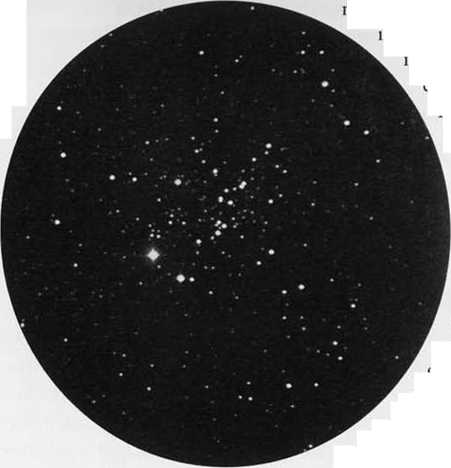
On November evenings the Milky Way arches over the pole like a phantom bridge. Here we are looking toward the outer regions of our galaxy where the star fields are less congested; a sweep of the telescope will reveal deep-sky objects peering out from the region's great swarms of stars. The W-shaped asterism of Cassiopeia appears to be a favorite proving ground for budding amateur astronomers scouting out deep-sky sights. Star-rich Cassiopeia does not disappoint, for it contains a fine assortment of open clusters scattered along the galactic equator, which passes through the constellation. "Curiously, amateurs seem to be relatively unfamiliar with most of these objects," Scotty wrote, "except the famous Double Cluster in nearby Perseus. Yet here are many open clusters that are relatively bright and easy to distinguish from the crowded star fields of the Milky Way. Cassiopeia, although usually not considered a hunting ground for clusters and not possessing any of the more interesting ones, is actually full of the smaller galactic clusters."
Novice observers have the universe before them to explore. To begin with, there are many dazzling and delightful objects which can be located almost effortlessly, such as the Orion Nebula, globular star cluster M13, and the Sagittarius star clouds. But what of the dimmer offerings, including many planetary nebulae and most of the NGC objects?
A fine harvest awaits the amateur who examines the Milky Way in Cassiopeia w’th a small telescope. Many readers have commented on the profusion of open clusters in the Cassiopeia Milky Way. Here we are looking toward the outer regions of our galaxy where the star fields are less congested and deep-sky objects are not lost among great swarms of stars. Still, some care is needed to recognize some of them against the starry background. On autumn evenings this region r|des high in the north, though it is awkwardly situated for finding objects with eciuatorially mounted refractors. Plate I of the Atlas of the Heavens shows 24 open dusters in the northern portion of Cassiopeia. An amateur who attempts to study •hem all will be kept busy for many nights.
^e’ll start this month off with several open star clusters 1 have selected near
Figure 11.1 Look for NGC 457 near the star Phi Cassiopeiae. This cluster has about 100 stars and is about the same brightness as the cluster M103, which lies about 2 72° to the northeast.

naked-eye stars in
- • «Ss*
topeia. It is usually Cas ier to pick out theSe clusters with a refractor work in§ at f/15 than with the fast f/4 to f/6 re. flectors that are popular today. For extended diffuse objects, faster optical systems give superior views, but when individual stars can be seen the high-power systems darken the sky background without diminishing the conspicuousness of the stars.
Queen Cassiopeia is usually portrayed seated in a chair, with the W as the constellation’s best-known part. Third-magnitude Delta (8) Cassiopeiae is the bottom point of the W’s eastern half, and just 2° to its southwest is 5th-magnitude Phi (<j>) Cassiopeiae. The open cluster NGC 457 is less than 10' west-northwest of the star and will be in the same low-power field of view. NGC 457 is a coarse group of distant suns which even shows well in a 2-inch aperture. This open cluster (Figure 11.1), 10' across, is a grand sight even in a 4-inch. The experienced French amateur G. Gauthier saw 50 stars here with a 6-inch reflector As the light-gathering power of the telescope increases, so does the number of stars that will be seen here, with a 20-inch revealing perhaps 100 stars appearing as bright pinpoints with dark sky between them. Many of this cluster’s stars are very faint, and even in the 20-inch refractor at Van Vleck Observatory in Middletown, Connecticut, scores of them dance in and out at the limit of vision.
Look about 40' northwest in the same field for NGC 436, a smaller cluster of fainter stars. (Be careful when observing the polar regions of the sky. for sky directions here will no longer match the corresponding compass points on the horizon.) When star-hopping from one location to another, it is important to know the actual field diameter of your eyepiece. Remembering how large the Moon (some /20 in diameter) appears in your telescope will enable you to estimate the field with enough accuracy for this purpose. NGC 436 is a better target for larger telescopes. A 3-inch aperture will pick up about half a dozen stars here, while a 10-inch will reveal many more, and possibly the background glow of oth ers just below the limit of visibility.
I Just southwest of Beta /p) Cassiopeiae arc two ^-magnitude stars, Sigma (o) and Rho (p) Cassiopeiae, which are rated by a little less than 2°. Halfway between them is NGC 7789, an open cluster with about the same apparent diameter as that of the Moon (Figure 11.2). It can be easily found with binoculars as a hazy patch. Discovered by
sepa-
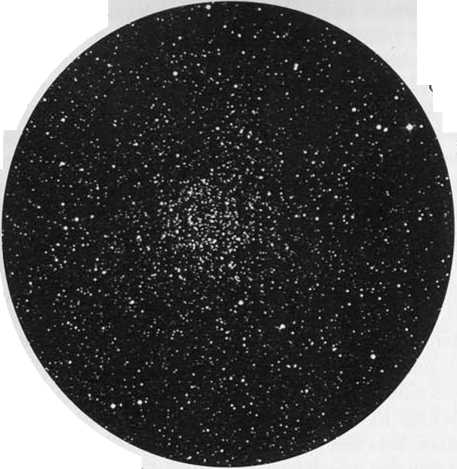
Figure 11.2
The extremely rich open cluster NGC 7789 in Cassiopeia lies about 6,000 light-years from the Sun and measures about 50 light-years across.
William Herschel’s sister Caroline in the autumn of 1783, it has inspired authors
since William H. Smyth, who in the mid-19th century called NGC 7789 a “mere condensed patch in a vast region of inexpressible splendor.” As examined in a 6-inch reflector by G. Gauthier, NGC 7789 is “a splendid swarm of about 200 stars of magnitude 10 to 12,” according to the observing manual Revue des constellations by Robert Sagot and Jean Texereau. Looking at this cluster, one may gain the impression of a knot of bright stars superimposed on a larger mass of faint points of light.
NGC 7789 is one of those rare objects that is impressive in any size instrument. With a 4-inch rich-field telescope the cluster appears as a soft glow nearly /i° across and speckled with tiny, often elusive, individual stars. The 12-inch f/17 Porter turret telescope at Stellafane picks up more than 100 stars. Through a 16-inch aperture the view is spectacular, and the whole field is scattered with diamond dust. And a 22-inch Dobsonian reflector in the clear skies of California gave a most impressive view with countless sparkling points filling an entire 60x field. I particularly like the draw-lng of NGC 7789 made by Smyth, who observed with a 6-inch refractor. He mentions that the cluster has “rays of stars which give it a remote resemblance to a crab.” He imagined the creature’s head to be in the northwest with a close double star near where the eyes would be. Does anyone see this pattern today?
Kappa (k) Cassiopeiae, above the W’s center, is the 4th-magnitude star marking the front edge of the Queen’s chair. Just 22' to its north and in the same low-power field is NGC 146. It is a compact cluster containing about 50 stars within a 6' diameter of sky. However, the Milky Way background is quite rich here, and magnifi-eations between lOOx and 200x, especially with 10-inch and larger telescopes, will he necessary to appreciate the cluster fully.
Less than !6° west of NGC 146 is a very similar open cluster, NGC 133 group shines with a light equal to that of a 9th-magnitude star. This area of the sky is historically interesting because the great supernova of 1572, Tycho’s star appeared some l'A0 northwest of these clusters. Attaining the brightness of Venus and remaining visible to the naked eye for 16 months, it was the most spectacular stellar outburst in the past 500 years. Although faint nebulosity believed to be associated with the explosion has been photographed with lar telescopes, it is well beyond the visual reach of amateur instruments.
NGC 225 lies 2° northwest of Gamma (y) Cassiopeiae, the famous irregular variable. The total light of the cluster matches a 7th-magnitude star. It was dis covered in 1784 by Caroline Herschel while comet hunting. William Herschel placed this cluster in his class VIII, which is reserved for coarsely scattered star clusters. W. H. Smyth described this as a loose cluster of about 30 9th- and 10th-magnitude stars. About 0.2° in diameter, it contains over a score of stars brighter than visual magnitude 13.1 prefer to view this object with my 4-inch Clark refractor, though it is quite evident in a 5-inch Moonwatch Apogee telescope.
NGC 129 is huge, having an apparent diameter as large as the full Moon. It lies midway between Beta and Gamma Cassiopeiae, and the 10 stars brighter than 10th magnitude in it are very scattered, so they do not define the cluster well. But on a very clear night, look with averted vision for a faint background glow caused by the dimmer stars. You'll need a 10-inch or larger instrument to resolve it, for it consists mainly of faint stars. As seen in a 10-inch reflector it is a triangle IT long. The brightest of its perhaps 50 stars is 9th magnitude
Cassiopeia contains the bright open cluster M52, which lies between Cassiopeia and Cepheus on the edge of the dark lane in the Milky Way that divides these two constellations. The early writers discuss the object under Cepheus, and there one should look for its description in either William Smyth's or Thomas W. Webb's catalogs. It arrived in Cassiopeia only in 1930 after the International Astronomical Union reorganized the official constellation boundaries.
M52 has a total magnitude of 7.2 and is visible in any finder. Recent studies indicate that this object is one of the richer and more compressed open clusters known. It is also relatively young, being some 20 million years old and comparable in age to the Pleiades. Unlike some open clusters, M52 shows increasing richness with larger-aperture telescopes. Smyth, viewing with a 6-inch instrument, was moved to call M52 an object of “singular beauty.”
Not large as galactic clusters go, it is 13' in diameter, but packed into that area are more than 150 stars of 11th magnitude and fainter. If it were not for its irregular outlines, M52 might well be mistaken for a globular cluster.
Only a little more than !4° southwest of M52 is the remarkable nebula NGC 7635. Although it is sometimes classed a planetary, it is hardly a typical member o this ill-defined group of objects. I first learned of this bubble of glowing gas in 19 when our Moonwatch station in Manhattan, Kansas, obtained a copy t'ie Skalnate Pleso Atlas of the Heavens which plotted it. In the transparent skies of the Great Plains my 10-inch reflector easily picked up the 3' nebulous disk surroun ail 8th-magnitudc star. My experience was that the nebula was best seen at 150x.
Here in Connecticut I have never been able to find NGC 7635 with a 5-inch Apogee telescope at 20x, and my 4-inch Clark refractor revealed it only on a few nights when the sky conditions were exceptional. Viewing from the Empire fountains of Arizona, Ron Morales saw the nebula as “two stars close together involved in nebulosity, roundish, faint, and large.” He was using an 8-inch at 5lx.
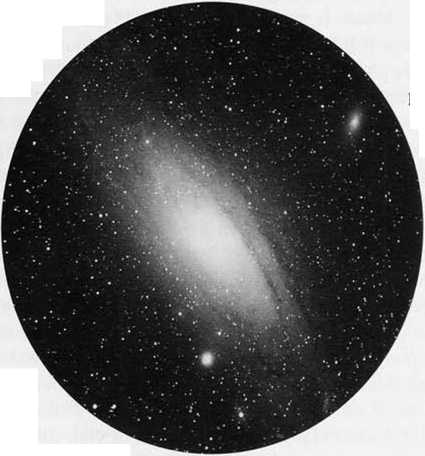
Figure 11.3
The great Andromeda Galaxy and its two bright companions — M32 (just below center) and M110 (at upper right).
Amateur astronomers long await the November cold fronts that ferry in clean arctic air over much of the United States. Although these nights are crisp and cold, they offer us some of the best nebula observing of the whole year. During these evenings, M31 — the great Andromeda Galaxy — can be glimpsed with the naked eye regardless of the observer's location in the city or out in the country. Since it is more than two million light-years distant, M31 is one of the most remote objects that can be seen without optical aid. Naturally, because it is bright, so well known, and so easy to locate, M31 is frequently the first deep-sky object sighted by novice telescopic observers. "Initially, many see nothing more than a blob of light," Scotty said. "But with time and patience, beginners gain the ability to perceive greater detail. Seasoned observers find bright and dark lanes, star clouds, and a starlike nucleus to be prominent features of the Andromeda Galaxy." Interestingly, the full visual extent of this galaxy was lost to observers for nearly a century. The mystery has since been solved, and Scotty was present when the tables turned.
November is a wonderful
month for observers, especially here in New England. If luck is with us
the days are mild and the nights are crisp and free of insect marauders. Ever since the summer solstice, the nights have grown longer and deep-sky viewing could begin earlier. The sweet perfume of red and golden foliage is in the air. The beau
ty of these evenings opens the poetic feelings locked deep inside us all.
November evenings, then, are a time to admire one of the most beautiful deep-sky sights of all — the Andromeda Galaxy, M31.
Well placed for observing near the meridian, M31 (Figure 11.3) lies a few degrees above Mirach, Beta (0) Andromedae, about 1° west of Nu Andromedae, and shines with a total light equivalent to a 4.5-magnitude star It seems the constellation boundaries of Andromeda were deliberately chosen so that nothing else would compete with thc Andromeda Galaxy for the deep-sk observer’s attention. And nothing can compare with it. M31 is relatively nearby being a member of the Local Group. It lies more than 2.2 million light-years distant and has an actual diameter of nearly 180,000 light-years, making it one of the largest galaxies known.
As early as the year 964 the Great Nebula in Andromeda, as M31 was once called, was described as a "little cloud” by the Persian astronomer al-SufT. This spiral galaxy can be seen with the naked eye even in a less than perfect sky Anything from an opera glass to the largest amateur telescope is suitable for viewing the galaxy. It is the chief glory of amateurs and a workhorse at public nights at observatories or star parties.
As with comets, M31 appears to have larger dimensions to the naked eye or through binoculars than when viewed with medium-sized telescopes, and the published values for its size vary widely. Most photographs of M31 show the spiral galaxy to be oval shaped, extending across some 2/2° of sky. This dimension is often given in catalogs. However, in 1847 with the 15-inch refractor at Harvard Observatory, George P. Bond traced the long axis to about 4°. His technique for observing the outer portions of the galaxy is still used today by amateurs searching for faint objects. Bond simply rocked the telescope back and forth, since the eye is better able to pick up a faint, low-contrast image when it is moving.
So strong is the desire to believe what astronomical photographs tell us that Bond’s observations have largely been overlooked even though they were mentioned in Webb’s Celestial Objects for Common Telescopes. That M31 is over 4° long was proven in the early 1930s, when Joel Stebbins of Washburn Observatory traced its extent with a photoelectric photometer. (I know, because I was a night assistant in the Washburn Observatory dome that evening!) This stimulated nty interest in reproducing the feat with the unaided eye, and I soon learned it was possible to do so on really excellent nights. Here is one of the cases where the eye can surpass photographic film. In 1953, the late French astronomer Robert Jonckheere, using 2-inch binoculars and taking extreme precautions, found the visible length to be 5° 10'. I can see the same with 15 x 75 binoculars. In fact, by moving the bright central region out of the field of view and by using averted vision, many people can do equally well with any low-power telescope. With my 5-inch Moonwatch Apogee telescope, I once seemed to reach 5°.
The apparent length of M31 is a sensitive measure of atmospheric trans parency. The slightest haze will drastically reduce what can be seen of the galaxy's faint extensions. I have never been able to see a greater dimension M31 with optical aid than I can with my naked eye. Indeed, Jonckheere liken the brightness of the galaxy's outer regions to that of the gegenschein. That faint glow is also seen best with the naked eye. A related project for the naked eye is to note how close thc edge of the Milky Way comes to M31. On really transparent nights I have seen thc luminous band come right up to M31 and then abruptly stop. On other nights a large separation appears between them.
Telescopically, M31 is often a disappointment. Few instruments can fit more than the galaxy’s central bulge in their field of view. If those in your group are familiar with photographs of M31, it would be best to tell them about the view through a telescope. Major features of the galaxy that are recorded by the camera are far more subtle in the eyepiece. Its spiral structure, first recognized in the mid-1800s by Ireland's Lord Rosse, probably cannot be seen in amateur instruments despite a few claims to the contrary. Another feature often lost in photographs is M31’s nucleus. The telescope shows a much brighter nucleus with the extensions quite faint. At low magnification the core of M31 appears as an even glow. But as the power is increased to several hundred or more, a tiny starlike nucleus becomes visible. High magnifications will help bring out this tiny, star-like part. With my 10-inch reflector in Kansas, this nucleus was very conspicuous in good seeing. Dark lanes in M31 can be identified even in small telescopes if the sky is dark enough.
A challenging project for the owner of a 10-inch or larger telescope is to locate the brighter globular clusters in M31. A description and finder chart for some of them appeared in the November 1979 issue of Sky & Telescope, page 490*. That idea came from Doug Welch of Ottawa, Canada. He had used his club’s 16-inch reflector to locate several of the brighter globulars, which had been selected from a list of nearly 250 suspect clusters in M31 compiled earlier this century by Edwin Hubble and Walter Baade (and cataloged with HB numbers).
After first mentioning these globulars in the November 1979 column, I received as much mail about them as about any other single topic. A few amateurs sighted some of the globulars easily, while others were just plain skeptical that such observations were possible.
Hank Feijth of Goutum, the Netherlands, held the brightest cluster, HB 12, steadily with his 6.1-inch reflector. He could also glimpse HB 64 and HB 254 with the same instrument. Feijth is an experienced variable-star observer with more than 30,000 magnitude estimates to his credit. On the other end of the experience scale was 15-year-old William Kinney of Whitefish, Montana. With a Celestron 8 he was able to view HB 12 as “fleeting with averted vision.” Unfortunately, space does not permit me to list all the amateurs who were able to see this cluster with only a 6-inch aperture. However, from the reports, it seems very likely that this is the minimum-size instrument for such an observation.
HB 254 was the second most observed globular, with several amateurs finding 11 (with difficulty) in 8-inch telescopes. The most complete report on these clus-
™3l's brightest clusters are plotted on the Millennium Star Atlas, too. tcrs came from veteran variable-star observer Thomas W. Wilson of Hunting West Virginia. He found all 15 known clusters with a 12/?-inch f/5.1 homemade Newtonian. HB 90 was his most difficult observation. I find his results with an 8 inch f/5.6 homemade reflector even more impressive. With it he missed HB 9(j and only suspected four others, but the remaining 10 clusters were either seen or clearly glimpsed.
M31's Companions
Not all the interesting objects associated with the Andromeda Galaxy are as taxing of the observer’s ability as the globulars just mentioned. Familiar to today’s amateurs are the companion galaxies M32 and M110. In a small telescope, M32 is well separated south of the disk of M31 and may be mistaken for M110, also known as NGC 205. The latter, however, is much farther away (0.6° from the center of M31) to the northwest. Both of these satellite galaxies are about 9th magnitude. Curiously, its companion galaxy M32 was not noticed until 1749, although at 8th magnitude, it is obvious in very modest instruments. Ml 10. nearly as conspicuous, was discovered as late as 1773 by Charles Messier.
Two more companion galaxies, NGC 147 and 185, lie about 7° north of M31 and are often overlooked by observers. Visually, both these galaxies are several arc minutes in diameter and around 12th magnitude. NGC 147 is often listed in catalogs as being slightly larger and with a total light less than that of NGC 185. Thus, one would reasonably assume that NGC 147’s surface brightness would appear noticeably fainter than NGC 185’s. However, this is not the case. To me, they usually appear quite equal, and several entries in my notebook even cite NGC 147 as appearing a trace brighter. What is your opinion?
While some writers suggest that a 6-inch telescope is needed to ferret out these companion galaxies from the fringes of the Milky Way in Cassiopeia, I have seen both in a 4-inch instrument. Also, observers with large-aperture telescopes might want to check out a report by Tokuo Nakamoto. Using the 30-inch reflector at Stony Ridge Observatory in California, he suspected NGC 185 as being “granular” and thus on the verge of being resolved.
Pisces, a long, dim, and usually neglected region of sky, is nearly a ghost town of deep-sky wonders. "Few ever probe this area," Scotty wrote, "for here are found no planetaries, clusters, or nebulosities." Rather, he pointed out, "Pisces is all galaxies. In the region between right ascension 0h and 2h and declination 0° to +20°, we list 17 of these outposts of perception." One reason amateurs neglect Pisces is that its weak cast of galaxies must compete with the nearby presence of "magnificent M31," and the somewhat elusive but "marvelous M33." Only one of Pisces' galaxies is bright enough to be a Messier object — M74 — and it is the fabled thorn in the side of amateurs participating in Messier marathons. Therefore few observers even bother to turn their telescopes to it, or to Pisces. But, as Scotty explains here, there are many galaxies in the 12th- to 13th-magnitude range suitable for an 8-inch telescope.
South of the Great Square of Pegasus is the vast emptiness of Pisces, wherein lies M74,one of the more frustrating Messier objects (Figure 11.4). This face-on spiral appears some 6' in diameter and is about 10th magnitude. It seems an easy
galaxy from its catalog description. yet it is considered by many to be the most difficult object in Messier’s list.
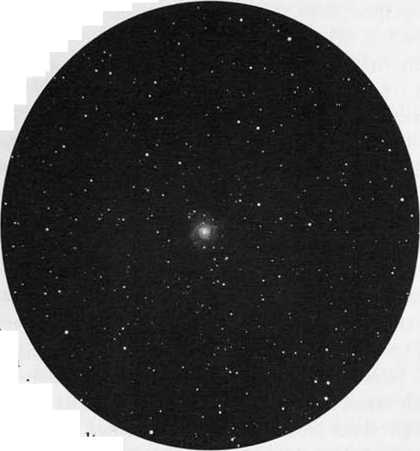
Figure 11.4
M74 is a two-armed spiral galaxy tilted 56° from our line of sight. It has a mass of some 58 billion Suns.
Many famous observers have commented on the difficulty of viewing M74. Pierre Mechain, who discovered the object in September 1780, wrote: “This nebula contains no star; it is fairly large, very obscure, and extremely difficult to observe. One can make it out with more certainty in fine, frosty conditions!” His friend Charles Messier agreed that the object was obscure. Both Smyth and Webb omitted M74 from their observing guides, as have a chain of succeeding writers. Nevertheless, I have seen it in my 4-inch Clark refractor with the aperture stopped down to 2.8 inches. The delicate, sharply defined arms of this galaxy are very regular, which together with the broadside presentation, makes this a perfect object of its type. The arms cannot be seen in small telescopes.
John Herschel mistakenly classified M74 as a globular cluster, and this was not the only time it was misidentified. M74 has a rather bright, almost starlike nucleus, and when the famous Bonner Durchmusterung charts were compiled from observations made with a 3-inch refractor, the galaxy was included as the “star" BD+15°238.
One of the reasons amateurs have difficulty locating M74 is that its light is rather evenly distributed across the disk, thus yielding a low surface brightness. Your chances of picking it up are improved if you prepare to see a large, dim mass. M74 is easy to find, 1!4° east and 27' north of Eta (q) Piscium. As a guide to this spiral galaxy, there is an easily identified chain of stars about a degree to the northeast and visible in the same low-power field. If the observer sets Eta on the southern edge of a low-power field and lets the stars drift across, M74 will enter the field in a few minutes. This technique has a good deal to recommend it for the eye becomes much more sensitive by staring at a relatively blank sky for a while. Also, try viewing this galaxy with averted vision, which should give a fur ther gain of up to a stellar magnitude. Indeed, in most observing locations eye sensitivity is decreased by stray light, overall sky light, and reflections from the telescope tube. By shielding the head and the eyepiece with a black cloth, as a portrait photographer does, the observer will surely increase his ability to see faint objects, such as M74.
Paradoxically, M74 can sometimes be seen more readily in binoculars or a finder than in a 6-inch telescope. Its feeble contrast with the surrounding sky makes this a tricky object in any aperture. In the mid-1920s I caught a glimpse of M74 with a 1-inch 40x refractor. This was quite possibly due to the sensitivity of my young eyes since I was still in grade school at the time. At 60x, the 4-inch Clark stopped to 3 inches shows M74 as a galaxy. However, at 2 inches a quick glance reveals just the stellar appearance that gave rise to the mistake on the BD charts. A 10-inch shows that the central portion is brightest. No spiral arms can be seen, but it is obviously not a “nebulous star,” as some older accounts suggest. There is no question about it being a galaxy when viewed with a 20-inch aperture, but even then the spiral structure is not apparent.
NGC 524, a 1.5'-diameter elliptical object listed at 11th magnitude, is easier to see than M74. Because NGC 524 has roughly a twentieth the surface area of M74, but is only about 2'Z> times fainter in total light, its average surface brightness is some eight times greater. Once again, we find that the relative visibilities of objects should not be judged on the basis of catalog magnitudes alone.
NGC 128 is another interesting galaxy in Pisces. It is a tiny torpedo-shaped object about 2' long and a quarter as wide, and I estimate it to be magnitude 12.2. It can be seen in my 5-inch Apogee telescope at 20x.This telescope works well here because the star background does not overwhelm the deep-sky objects the way it does in places like the Milky Way in Aquila. NGC 128 has a challenging feature for observers: its central core is rectangular in appearance. Years ago in Kansas I could see this shape quite well with a 10-inch reflector, but it is beyond the grasp of the 4-inch Clark.
Smyth mentioned another difficult Pisces object, near the western end of the constellation: NGC 7541. It lies 1.4° north-northwest of the 4th-magnitude star Gamma (y) Piscium. This 3' long oval is similar in magnitude to NGC 128. As viewed with his 6-inch refractor, this galaxy appeared “so dim as to be only perceptible under settled gazing, and clock-work motion, when it faintly gleams among the telescopic stars in the field.” Yet my 5-inch Apogee telescope on a good night in Connecticut distinctly shows this 3' by T spindle, which I estimate as of visual magnitude 11.8.
Pisces also contains the interesting but elusive set of twin galaxies NGC 470 and NGC 474, which are separated by just 6'. While catalogs differ as to which of them is brighter, I favor NGC 470 with a magnitude of 11.2. They were found quickly one night when I observed at my former home in Kansas, but there have been many nights here in Connecticut with my 4-inch Clark refractor when this instrument would not reach them. I wonder if they would be seen more in a sky of better transparency. This galaxy’s light is concentrated within a 2' patch, and it is seen in the field of my refractor’s lOx eyepiece without any trouble.
Nearby is another pair of galaxies, this time more suitable for a 16-inch aperture. NGC 7619 and NGC 7626, separated by 7', are located on the border of Pisces and Pegasus. They are both about 1' in diameter and have cataloged magnitudes of around 12.7. There are over a dozen NGC objects within a 2° radius of this pair, and 1 suspect that many of them would be visible with a 10-inch telescope used in good skies.
As a challenge, look for NGC 7534, which is a part of a small chain of very faint galaxies a little more than 1° long running roughly east to west just below the celestial equator. A 16-inch telescope may be needed to show all of them. Work through this group carefully.
Although Northern Hemisphere observers cannot view the south celestial pole, they can see the South Galactic Pole and the splendors surrounding it in Sculptor. This dim constellation remains low in the southern sky for observers in mid-northern latitudes. However, its placement — as Scotty reminds us — is as good as the Milk Dipper of Sagittarius and the tail of Scorpius, which amateurs probe every summer night. "Sculptor contains many objects that would be the talk of every late-summer star party," he imparted, "if it were not for their relatively poor placement near the southern horizon." It's true. Without question, the deep-sky objects in Sculptor are some of the best in the entire sky, so they are well worth hunting down on those exceptional nights when cold fronts scrub the haze from the horizon and allow us to slant our telescope tubes ever deeper toward the south.
mateurs find it difficult to obtain visual descriptions of clusters and nebulae /Vwith large southern declinations. There is the extensive 1847 catalog of John Herschel, but the Southern Hemisphere seems never to have had a Smyth or a
Webb.
Observers who have seen the whole sky often contend that some southern objects surpass the best the north can offer. When a clear, dark night is at hand, amateurs in mid-northern latitudes should attempt to view some of these southern wonders. Though low in the sky, their image quality is occasionally surprising. In November one may easily explore to the South Galactic Pole (declination -27°) in Sculptor.
Less than a degree from the South Galactic Pole lies NGC 288. This interesting globular cluster (Figure 11.5) is often overlooked by amateurs, though I readily find it whenever the sky is especially clear. One August, after a cold Canadian high had swept the air clean, binoculars were sufficient to distinguish NGC 288, which I make to be 12' in diameter and of , visual magnitude 7.0. Cata-' logs give its diameter as about 10', but
Figure 11.5
Look for the loose globular cluster NGC 288 in the constellation Sculptor. Larger telescopes reveal a bright core of stars.
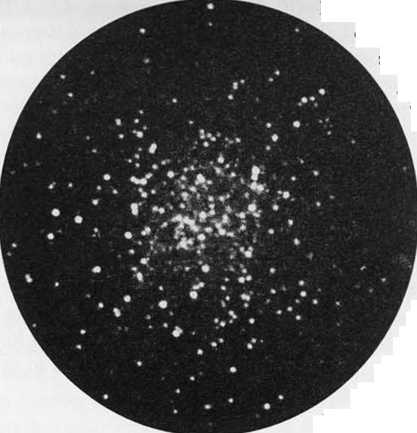
John Herschel made it only 5' across. It should be visible in a finder.
Ronald Morales of
Arizona notes that NGC 288 is
larger than M15 in Pegasus, but otherwise the two globulars appear about the same. In a pair of 5-inch 20x binoculars, it was possible to see individual stars around the edge of the cluster. And with a borrowed 12%-inch f/8 Newtonian reflector, the cluster could be resolved almost to its center. Only the regularity of the star pattern indicated that NGC 288 was a globular and not a compact open cluster. Furthermore, open clusters are concentrated along the Milky Way.
About 1.5° to the northwest is NGC 253, one of the largest galaxies in the southern sky (Figure 11.6). It is about 25' long (almost as long as the Moon is wide) and one-third as thick. At 7th magnitude it is a spectacular object for visual observers and astrophotographers alike. It is one of the 14 neb-u|ae and clusters discovered by Caroline Herschel in England during her sweeps for comets in the years 1782-83. Obser
Figure 11.6
NGC 253 is a member of the Sculptor Group of galaxies, and a known radio source. It can be found with a 6-inch telescope, but a larger instrument is required to see the details of its dusty arms.
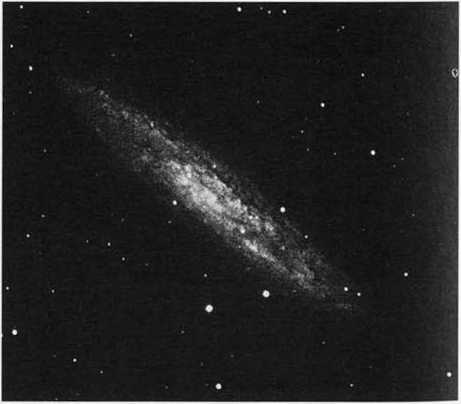
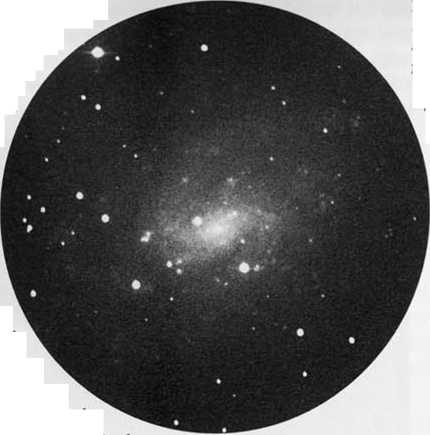
Figure 11.7
NGC 300 is among the largest galaxies in the sky. It resembles
M33, with a compact nucleus and beautiful spiral arms full of nebulae and stars.
its appearance in his 18%-inch
what streaky, but I see no stars in it except 4 large and 1 very small one, and these
ving from the Cape of Good Hope a half-century later, her nephew John Herschel described speculum-metal reflector: “Very, very bright and large; a superb object... 24' in length; breadth about 3'; position angle of long diameter 143.8°. Its light is someseem not to belong to it, there being many near.”
The galaxy was easily seen in Vermont with a 6-inch rich-field at about 20x. Long-exposure photographs reveal a complicated pattern of dust lanes and patches across its surface. Morales notes the galaxy’s internal mottling as “very impressive” seen with a 6-inch f/8 reflector. In the Wright telescope it was quite bright, and dark lanes were just visible. The sight reminded me a little of M31 in a 1.5-inch refractor in Connecticut.
There is always the possibility of discovering a supernova while viewing galaxies, but the chances are slim. One difficulty is that amateur telescopes usually reveal only the bright inner core of a galaxy, and an outlying supernova will look like any other field star. This was my experience in 1972 when viewing the bright supernova that erupted in NGC 5253 in Centaurus. Of course, if an unfamiliar star is seen superimposed on the galaxy’s image, it is a much more likely supernova candidate.
Southward from the galactic pole and near the 5th-magnitude star Eta (r|) Sculptoris is NGC 134. Though llth-magnitude and only 5'x l'in size, this object was held steadily in my 4-inch Clark refractor. The view was not as good as one I had from Louisiana in 1943. But despite its low altitude NGC 134 is no more difficult than NGC 6207, a well-known spiral galaxy near M13.
If you have an unobstructed horizon, try adding two even more southerly galaxies to your Sculptor list. NGC 300 is another large spiral (Figure 11.7) seen ‘ace-on that spans 20' by 10'. Steve Coe of Arizona found it to be very much like the well-known M33 in Triangulum. With a 13-inch telescope he can just discern a dim S-shaped structure. To my eye its total light is equivalent to an 8.5-magni-tude star, but since it is spread out over so large an area, the surface brightness is low. Care is needed to locate this object, but it can be seen in a 5-inch Moonwatch Apogee telescope. With a 10-inch reflector in Kansas, I found this galaxy to be fascinating, with abundant detail that challenges anyone who attempts to make a drawing.
Figure 11.8
While scanning the Sculptor Croup, look for the large spiral galaxy NGC 55. It lies within 15° of the South Galactic Pole.
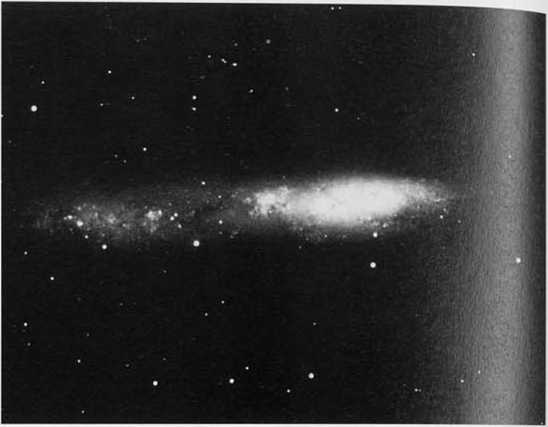
Some deep-sky objects offer beautiful, breathtaking visual experiences. NGC 55 is one such object (Figure 11.8). It is the largest galaxy in the nearby Sculptor Group and by itself is one of the giants of the southern sky. In fact, these objects form the nearest cluster to our Local Group, being only some 13 million light-years away. From observations made in Mexico, where NGC 55 rises much higher than as seen from most of the United States, I estimated its total magnitude to be 7.1. When 1 first saw NGC 55 in binoculars from Chiapas, I was surprised that such low power would reveal this galaxy so clearly.
Most amateur telescopes can trace NGC 55’s slender, spindle-shaped form across 20' of sky. Long-exposure photographs record more than a Z° length, and densitometer measurements of these negatives reveal a disk that approaches 1° long. This makes it an excellent candidate for viewing in a black sky with binoculars. Remember that the Andromeda Galaxy, M31, can be visually traced out to almost 5° with binoculars, whereas photographs usually stop at 2%°. Has anyone tried viewing NGC 55 with a light pollution filter? The results might be surprising-
Houston, Texas, amateur Barbara Wilson, whose prowess as a deep-sky observer is legendary, sent some of her notes regarding NGC 55. “August 9,1986. 3 a.nt., seeing good, very transparent night at Columbus, Texas. Using the 13.L inch [at 115x], NGC 55 appears very large, extremely elongated, very mottled, slightly tilted, very bright, however east end fades rapidly.”
A year later from the same site she viewed NGC 55 again, this time with a j7.5-inch telescope: “A long streak narrower at one end with mottling in the central region visible at 97x. It fills the 0.52° field of a 21-mm eyepiece. Incredible! Spiral almost edge-on. extremely bright, dimmer [east] end seen easily as it lades into the sky background, it is wider, but of lower brightness, than west end."
Makes you want to go out and take a look tonight, doesn’t it?
The Sculptor Dwarf Challenge
Can the famous Sculptor Dwarf Galaxy be detected visually? I still remember the excitement in 1938 when Harvard astronomers announced a hitherto unknown stellar system at only about an eighth the distance of the great Andromeda Galaxy, M31.
Although it has a total magnitude of about 8 and is more than a degree in diameter, the Sculptor system is most elusive because of its very low surface brightness. It consists of a loose swarm of thousands of stars of magnitude 18 and fainter.The discovery was made on a photograph taken with a 24-inch telescope, with a long enough exposure for the individual stars to show.
But the Sculptor system was also detected on a plate exposed for 23.3 hours with a 1-inch f/13 patrol camera, which revealed it as a very dim, unresolved smudge. Harvard’s medium-sized photographic instruments recorded nothing.
The best hope of seeing the Sculptor Dwarf Galaxy (Figure 11.9) is probably with a small, low-power, wide-field telescope or big binoculars, on an exceptionally clear night. Success may require considerable observing skill and first-class vision. Amateurs with fast telephoto lenses of medium focal length (300- to 500-mm) can record this system.
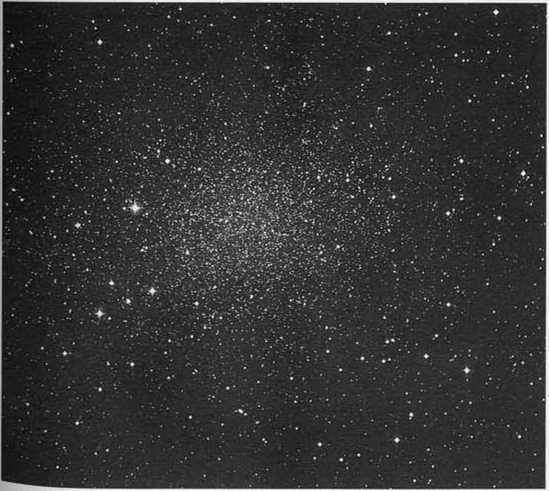
Figure 11.9 The loosely organized Sculptor Dwarf Galaxy measures a mere 8,000 light-years in diameter and has a mass of only about 2 million Suns.
On November evenings Sculptor is near the meridian about the time evening twilight ends. The elusive galaxy is about 4° south of 4th-magnitude Alpha («) Sculptoris. When I first presented readers with a Sculptor challenge in 1971, no one answered. This wasn’t surprising since the galaxy consists of very dim stars spread over a very large area. Some people have compared the galaxy to a huge globular cluster with 99 percent of the stars removed. Recently, however, I received a letter from Steve Coe in Arizona. From a dark-sky site he had searched without success for the Sculptor system with a 17/z-inch reflector. He then tried a 4/2-inch f/4 reflector at 16x. After carefully dark-adapting his eyes and covering his head with a dark cloth to prevent stray light from interfering with the view, he swept the sky again There it was, a blob of light without any detail, but visible nonetheless. Why don't you give it a try?
It's ironic, but we amateur astronomers often miss the forest for the trees. How many nights have we spent squinting behind an eyepiece just to glimpse the dim and fuzzy glows of distant galaxies? How many nights have we tried to seek out hyperfine details — a dust lane, a stellar nucleus, an H II region, a knot — within these ghostly extragalactic bodies? And while we strain our eyes, the most detailed galaxy of all goes virtually unnoticed. It's called the Milky Way, and we hardly know what it looks like to the naked eye. In the November 1990 Deep-Sky Wonders column, Scotty awakened himself — and us — to that obvious fact. While attending the Texas Star Party one spring, he sat in a chair under the stars and rediscovered the Milky Way. "1 just observed," he said, "with that marvelous and often ignored optical instrument, the human eye."
One of the best observing experiences of my life came unexpectedly in May 1990 at the Texas Star Party (TSP). From 11 p.m. to 3 a.m. I simply sat in a chair and watched the Milky Way.
Held in the shadow of Mount Locke, home of McDonald Observatory, the TSP usually has the best observing conditions of the big three annual conventions in the United States — the other two being the Riverside Telescope Makers Conference in California and Stellafanc in Vermont. The TSP has virtually no light pollution, and this year the air was very dry and transparent. The stars actually looked like sharp points.
For my Milky Way survey I used no telescope, though several dozen were close at hand and probably mine for the asking. The little 8 x 15 binoculars never left my shirt pocket, either. Even my Lumicon nebula filters, which I’m never without these days, stayed safely in a box. I just observed with that marvelous and often ignored optical instrument, the human eye.
Furthermore, I just looked at the summer Milky Way (Figure 11.10a and b)-1101 searching for anything in particular but alert for anything unusual. I wanted
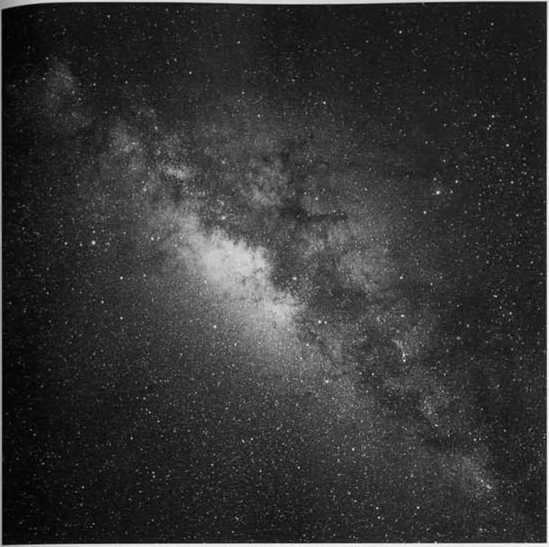
Figure 11.10a
The glorious summer Milky Way and the Sagittarius star cloud.
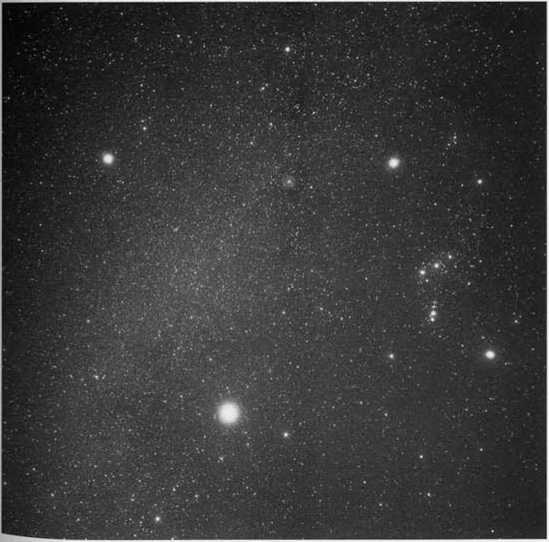
Figure 11.10b
The sparkling winter Milky Way, accompanied by the constellation Orion and the bright star Sirius. purely naked-eye impressions, not photographic, not photoelectric, only what I could see.
It was a wonderful experience.The turbulent star clouds appeared so crisp and well-defined. The most luminous part of the strip, running from Cygnus at the zenith to below Scorpius on the mountainous southern horizon, was remarkably narrow. I was suddenly struck by how thin the disk of our galaxy really is. and how closely packed the stars are within it. I was also surprised by the band’s straightness. The concept of thc Milky Way as an ill-defined, irregular, pythonlike stellar monster had given way to thc image of a slender shaft following a purposeful straight line across the sky. It was not a sight you glean from looking at star maps. I now have a better feel for the legends that call thc Milky Way the backbone of the sky.
I was most surprised by how isolated Antares and the globular cluster M4 are from the galactic disk. Except for a faint haze, the sky east of Antares is vacant — rather like the sky west of M4. which all star charts place outside the edge of the Milky Way. Now, you can reason that the void east of Antares is due to dark dust clouds, and this is fine scientifically. But the eye is not aware of what is happening here, and thus Antares appears outside the Milky Way.
In getting this column together I searched through my library for amateur oriented books that devote solid space to the visual Milky Way. I found many brief accounts of localized areas such as the star clouds of Cygnus and Sagittarius, but little on the naked-eye Milky Way as a whole. Then I turned to Garrett P. Serviss’s classic Astronomy with the Naked Eye. It contains an entire chapter on the subject. Serviss relates a folk tale he picked up from Lafcadio Hearn, a turn-oi the-century writer who used words to paint full-color pictures in three dimensions.
According to Hearn, several Eastern cultures had variations on a tale of a herdsman falling in love with a weaver named Orihimd. In anger, Orihimd’s father banishes the lovers to thc sky where they become the constellations Aquila and Lyra. Once a year they are allowed to meet if they can cross the Celestial River of the Milky Way. Serviss concludes his chapter by quoting Hearn:
In the silence of transparent nights, before the rising of the moon, the charm of the ancient tale sometimes descends upon me out of the scintillant sky, to make me forget the monstrous facts of science and the stupendous horror of Space. Then I no longer behold the Milky Way as that awful Ring of the Cosmos ... but as the very Amanogawa itself — the River Celestial. I see the thrill of its shining stream, the mists that hover along its verge, and the water-grasses that bend in the winds of autumn. White Orihime I see at her starry loom, and the Ox that grazes on the farther shore — and I know that the falling dew is the spray of the Herdsman’s oar.
Although the Milky Way has forever been so conspicuous in the night sky that it is woven into folk tales everywhere around the world, it is slowly attaining the status of a “test object” because of the ever-spreading threat of light pollution.
NOVEMBER OBJECTS
|
Nome |
Type |
Const. |
R. A. h m |
Dec. o / |
Millennium Star Allas |
Uranometria 2000.0 |
Sky Atlas 2000.0 |
|
Andromeda Galaxy, M31, NGC 224 |
Gx |
And |
00 42.7 |
+41 16 |
104,105 |
60 |
4,9 |
|
M32, NGC 221 |
Gx |
And |
00 42.7 |
+40 52 |
105 |
60 |
4,9 |
|
M52, NGC 7654 |
OC Gx |
Cos Psc |
23 24.2 01 36.7 |
+61 35 +15 47 |
1069, 1070 194 |
15,34,58 173 |
3 |
|
'_M74, NGC 628 |
10 | ||||||
|
"mTiO, NGC205 |
Gx |
And |
00 40.4 |
+41 41 |
105 |
60 |
19 |
|
TgC 55 |
Gx |
Sd |
00 14.9 |
-39 11 |
410,430 |
350,351, 386 |
18,23 |
|
NGC128 |
Gx |
Psc |
00 29.2 |
+02 51 |
245,269 |
216 |
10 |
|
NGC129 |
OC |
Cas |
00 29.9 |
+60 14 |
49,50 |
15,35,36 |
1,3 |
|
NGC133 |
OC |
Cas |
00 31.2 |
+63 22 |
36, 49, 50 |
15 |
— |
|
NGC134 |
Gx |
Sd |
00 30.4 |
-33 15 |
387,409 |
351 |
18 |
|
NGC146 |
OC |
Cas |
00 33.1 |
+63 18 |
36, 49, 50 |
15,16 |
— |
|
NGC 147 |
Gx |
Cas |
00 33.2 |
+48 30 |
85 |
60 |
4,9 |
|
NGC185 |
Gx |
Cas |
00 39.0 |
+48 20 |
85 |
60 |
4,9 |
|
NGC 225 |
OC |
Cas |
00 43.4 |
+61 47 |
49 |
16,36 |
1,3 |
|
NGC253 |
Gx |
Sd |
00 47.6 |
-25 17 |
364 |
306,307 |
18 |
|
NGC288 |
GC |
Sd |
00 52.8 |
-26 35 |
364, 386 |
307 |
18 |
|
NGC300 |
Gx |
Sd |
00 54.9 |
-37 41 |
408 |
351,352 |
18 |
|
NGC436 |
OC |
Cos |
01 15.6 |
+58 49 |
48 |
36 |
— |
|
NGC457 |
OC |
Cas |
01 19.1 |
+58 20 |
48 |
36 |
1 |
|
NGC470 |
Gx |
Psc |
01 19.7 |
+03 25 |
242,243, 266, 267 |
217,218 |
10 |
|
NGC474 |
Gx |
Psc |
01 20.1 |
+03 25 |
242, 243, 266, 267 |
217,218 |
10 |
|
NGC 524 |
Gx |
Psc |
01 24.8 |
+09 32 |
218, 242 |
173 |
10 |
|
NGC7534 |
Gx |
Psc |
23 14.5 |
-02 39 |
1281,1305 |
258, 259 |
— |
|
NGC7541 |
Gx |
Psc |
23 14.7 |
+04 32 |
1257 |
258, 259 |
17 |
|
NGC7619 |
Gx |
Peg |
23 20.2 |
+08 12 |
1256, 1257 |
214 |
17 |
|
NGC7626 |
Gx |
Peg |
23 20.7 |
+08 13 |
1256, 1257 |
214 |
17 |
|
NGC 7635 |
BN |
Cos |
23 20.7 |
+61 12 |
1069, 1070 |
15,34,58 |
3 |
Ast = Asterism; BN = Bright Nebulo; CGx = Cluster of Goloxies; DN = Dork Nebulo; GC = Globular Cluster; Gx - Goloxy; OC = Open Cluster; PN = Monetary Nebulo; * = Star; ** = Double/Mulliple Sfor; Vor = Vorioble Sfor
NOVEMBER OBJECTS (CONTINUED)
|
Name |
Type |
Const. |
R.A. h m |
Dec. o / |
Millennium Star Atlas |
Uranometria 2000.0 |
|
NGC 7789 |
OC |
Cas |
23 57.0 |
+56 44 |
50,66, 1069,1083 |
35 |
|
Sculptor Dwarf Galaxy, ESO 351-G30 |
Gx |
Sd |
00 59.9 |
-33 42 |
408 |
351,352 |
Ast = Asterism; BN = Bright Nebulo; CGx = Cluster of Galaxies; DN = Dork Nebulo; GC = Globular Cluster; Gx = Galaxy; OC = Open Cluster; PN = Plonefory Nebulo; * = Slor; * » = Double/Mulliple Star; Vor = Variable Star